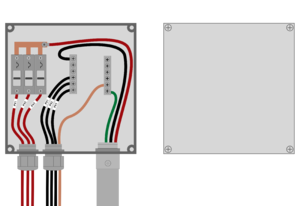Difference between revisions of "Combiner box"
m (Text replacement - "[[Special:MyLanguage/Series and parallel" to "[[Special:MyLanguage/Series and parallel connections") |
|||
| (14 intermediate revisions by the same user not shown) | |||
| Line 1: | Line 1: | ||
| − | [[Category: | + | [[Category:PV source]] |
| − | + | <languages /> | |
| − | + | <translate> | |
| − | Combiner boxes are typically installed outdoors and should therefore be designed to properly withstand the conditions in which they will be installed - see [[Weather | + | <!--T:1--> |
| + | [[File:Combinerboxpos201103.png|thumb|right|An example of a combiner box with three strings of PV (red and black) and a ground entering from the PV source. These PV strings pass through breakers that serve as overcurrent protection before being combined into one single circuit of larger wire size that exits in a conduit.]] | ||
| + | |||
| + | <!--T:2--> | ||
| + | Combiner boxes are used to bring together [[Special:MyLanguage/Series and parallel connections|series]] strings of modules with [[Special:MyLanguage/Series and parallel connections|parallel]] connections, to transition to larger or different [[Special:MyLanguage/Conductor types|wire types]] and to serve as an [[Special:MyLanguage/Disconnect|equipment disconnect]] for the PV source. A combiner box with 3 or more parallel strings should also include [[Special:MyLanguage/Overcurrent protection|Overcurrent protection devices]] as a [[Special:MyLanguage/Electricity and energy#Circuits|short circuit]] could result in all of the current of the other series strings feed through the string with the fault. A combiner box could be as simple as a basic junction box with [[Special:MyLanguage/Wiring practices|wire nuts]] to a pre-manufactured box with multiple overcurrent protection devices and a remote disconnection switch. | ||
| + | |||
| + | <!--T:3--> | ||
| + | Combiner boxes are typically installed outdoors and should therefore be designed to properly withstand the conditions in which they will be installed - see [[Special:MyLanguage/Weather rating|weather ratings]] for more information. For a combiner box to be properly watertight, it is also necessary that the [[Special:MyLanguage/Conduit|proper conduit and connectors]] are used. | ||
| + | |||
| + | ==Notes/references== <!--T:4--> | ||
| + | </translate> | ||
Latest revision as of 11:08, 2 March 2021
Combiner boxes are used to bring together series strings of modules with parallel connections, to transition to larger or different wire types and to serve as an equipment disconnect for the PV source. A combiner box with 3 or more parallel strings should also include Overcurrent protection devices as a short circuit could result in all of the current of the other series strings feed through the string with the fault. A combiner box could be as simple as a basic junction box with wire nuts to a pre-manufactured box with multiple overcurrent protection devices and a remote disconnection switch.
Combiner boxes are typically installed outdoors and should therefore be designed to properly withstand the conditions in which they will be installed - see weather ratings for more information. For a combiner box to be properly watertight, it is also necessary that the proper conduit and connectors are used.
